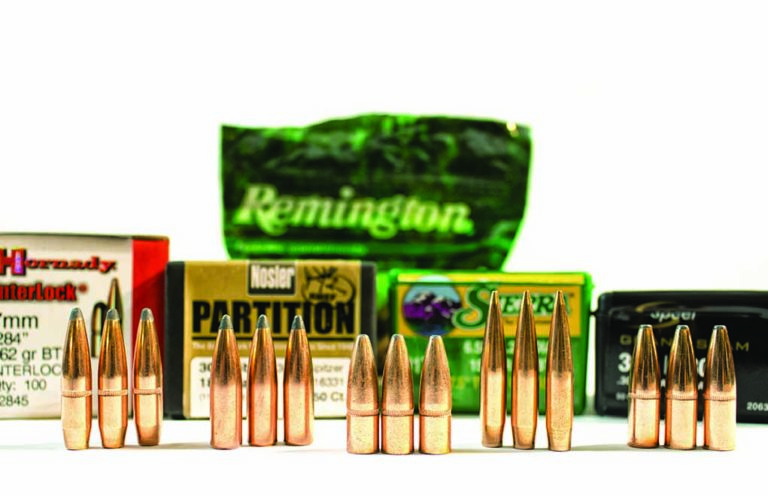
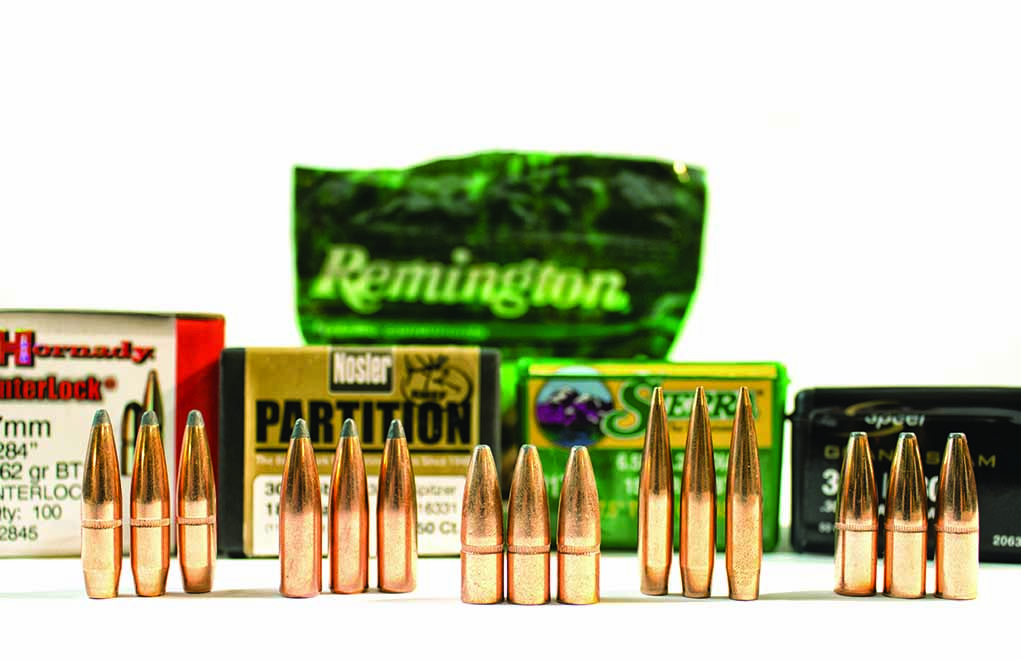
Mainstays for decades, these four time-tested hunting bullets still prove among the best for putting meat on the table year in and out.
What Are The Best Classic Hunting Bullets:
Bonus: Classic Match Bullet
In his thick Scottish accent, Ronnie Hepburn asked me a simple question: “Can you shoot with all these midgies!?”
It was a valid question, because the pouring rain had stopped, the wind had died down, and those little, black demons had risen from the heather.
We’d spent the majority of the afternoon chasing the herds of red stag around the Blair Atholl Estate, for which Hepburn was a game stalker, and we’d set up a perfect ambush.
With the old stag, which had been rolling in the peat while tending his hinds, facing head on at 245 yards, I leaned the forend of the graceful Rigby Highland Stalker on Hepburn’s pack, let my breath halfway out, gave the stag 6 inches of elevation and squeezed the trigger.
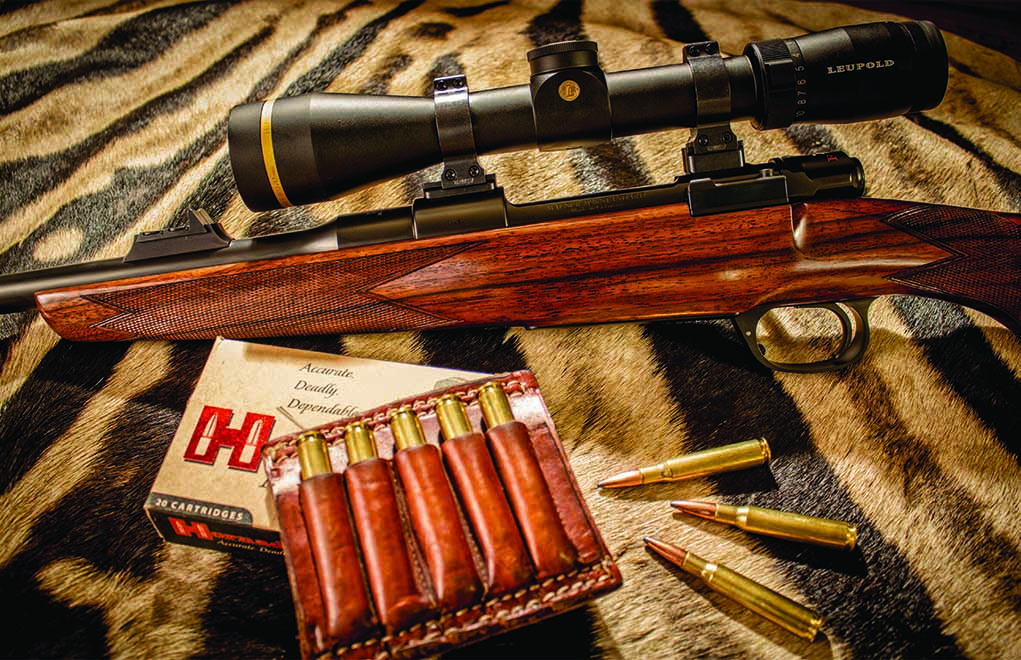
The sound of the Hornady 165-grain InterLock from the .30-06 Springfield striking flesh was undeniable and, within 25 yards, the stag was down for good. Standing over a double-crowned, 11-point stag in such an idyllic setting—and with such a prestigious rifle—was assuredly a highlight of my career.
Being a bullet guy, I wondered to myself why they hadn’t opted to use a premium bullet for such a unique opportunity. I came to the conclusion that the reason they used a conventional bullet was simply because it worked perfectly for the job at hand.
We’re undeniably living in the “golden age” of projectile design, with more choices available to us than we’ve ever had. Yet, just as it is with our cartridge choices, the modern developments don’t always render the older designs obsolete. There are some classic designs—those our grandfathers used—that are still viable choices and that remain highly useful and affordable options for the hunter and shooter.
Let’s look at some of those designs and how they apply to the range and hunting fields.
Hornady InterLock
I thought we’d start with this one, because I mentioned it in the above story, and it’s been putting meat in the freezer for more than 40 years.
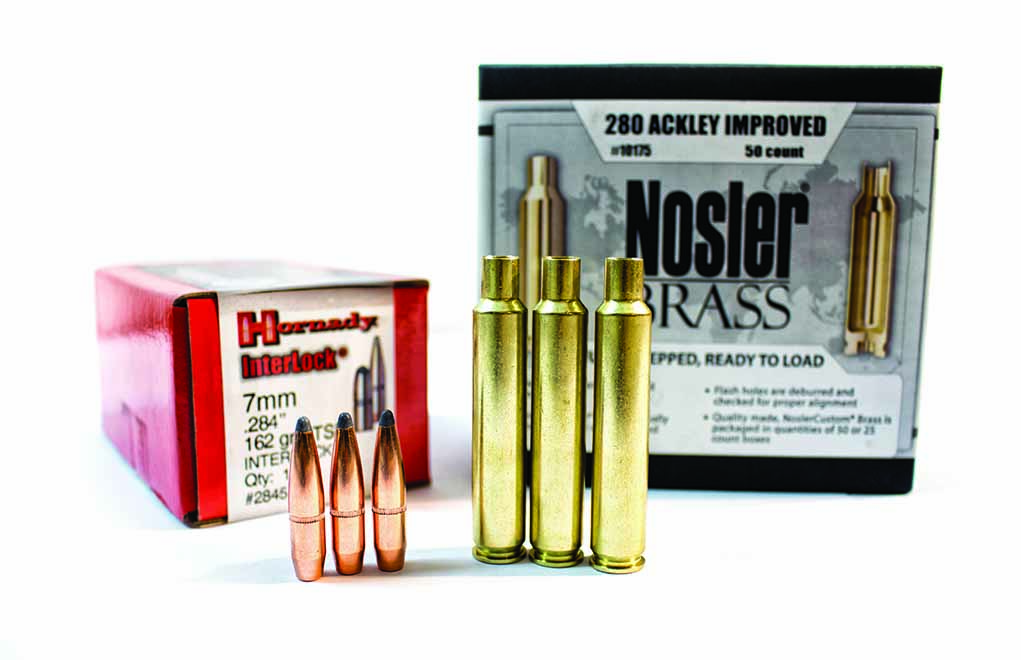
Joyce W. Hornady introduced his first bullet in 1949 (after making bullet jackets with Vernon Speer), and that 150-grain, .308-inch-caliber spire-point developed his reputation.
Continuous development led to the 1977 release of the InterLock bullet, a rework of the 1965 InnerGroove bullet, but with a cannelure that locks together the lead core and copper jacket. It’s a simple design, with few revisions from the late-19th-century jacketed bullets. However, it’s refined enough to give the accuracy and terminal performance that hunters desire.
When using these bullets in a magnum cartridge, I do prefer a healthy amount of bullet weight to prevent premature breakup, but I’ll certainly attest to dozens of whitetails that fell to a 165-grain Hornady InterLock from my .308 Winchester. It was the first component bullet I ever loaded and hunted with. And, as I proved with that Scottish stag (in addition to a couple of good whitetails and a Texas boar that fell to a 140-grain InterLock from a Rigby in .275 Rigby), it’s “enough” bullet.
Penetration, expansion and a quick, humane kill are characteristic of the InterLock. Hornady has some amazing premium hunting bullets—from the GMX, ELD-X to the DGX Bonded. But, for the annual fall deer hunt, it’s hard to argue with the InterLock.
On-Target Bullet Info:
- Cup-And-Core, The King Of Deer Bullets?
- Do Hornady A-Tip Bullets Change The Long-Range Game?
- Dissecting Threat-Stopping Defensive Bullets
- 5 Dangerous Game Bullets To Bet Your Life On
- The Unique Challenges, Performance of Monometal Bullets
Nosler Partition
Perhaps on the other end of the spectrum, John A. Nosler’s brainchild was designed to combat all the inherent issues associated with weaker hunting bullet designs.

Nosler was carrying a .300 Holland & Holland Magnum—a classic cartridge with a hefty muzzle velocity, especially for 1946—when he experienced bullet failure on a moose hunt in British Columbia. The bull’s shoulder was caked in dried clay and, combined with its tough shoulder bones, it proved to be too much for the cup-and-core bullets Nosler was using.
Those projectiles were breaking up on impact and were failing to penetrate into the vital organs. Nosler decided to build a bullet that couldn’t fail—and he did so. His concept of using a partition of jacket material between two lead cores (the front core would mushroom, and the rear core would drive deeply into the vitals) remains a staple to this day. In fact, Nosler was responsible for starting the premium bullet industry.
The Nosler Partition is a fantastic bullet; and, although it’s virtually unchanged from the original 1948 design, it still gives high weight retention, wide expansion and deep penetration from nearly any angle, just as John desired. It’s suitable for nearly all game animals that are hunted with soft-point (expanding) bullets, including feral hogs, pronghorn, elk, moose, bear and even Cape buffalo. While it might not have eye-popping B.C. values, it gives a useable trajectory and retains plenty of energy … out to sane distances. I used a Nosler Partition to take my best whitetail buck in my native New York’s famous Catskill Mountains, where the black bears grow to “respectable” proportions.
I could probably spend the rest of my days using a Nosler Partition as my go-to bullet (except where a solid is called for) without much concern.
Remington Core-Lokt
“The Deadliest Mushroom in the Woods” has been Remington’s siren call since 1939.
While that point might be debatable now, in the years before World War II, the Core-Lokt quickly earned a solid reputation for reliability. Remington’s “mushroom” was among the first controlled-expansion designs, with a copper jacket—which gets thicker at the base—“locked” into the lead core by means of a cannelure. Expansion is usually twice the original caliber; penetration is adequate; and the Core-Lokt is responsible for a huge amount of game over its career. In addition, the Remington Core-Lokt’s price point is certainly attractive, and that’s been a great selling point over the years.
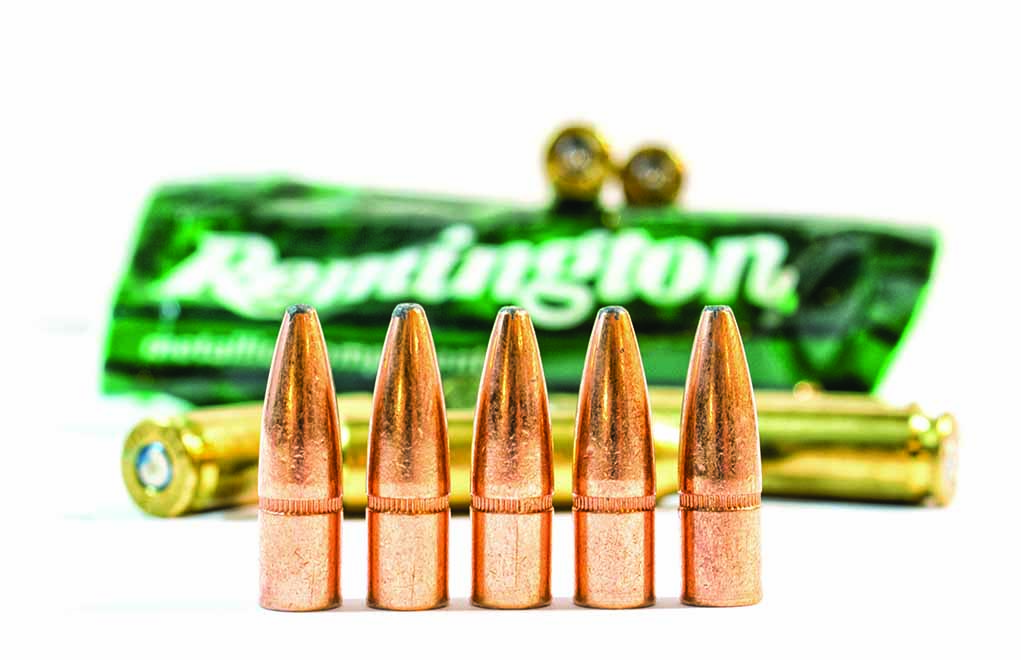
I took my first few deer with the contents of the green-and-yellow box of 170-grain Core-Lokt .30-30 Winchester ammo, so it has a special place in my hunting memories.
Is it a great choice for heavyweights such as brown bear and bison? Frankly, there are better choices for that job, but the Core-Lokt is one helluva deer bullet. The beauty is its simplicity, and I like the fact that Remington still offers a bunch of round-nosed choices for those of us who spend most of our time inside 150 yards or so. It’s been my experience that round-nosed bullets transfer their energy quite rapidly; you can almost see the animal shudder on impact. If you hunt at ranges for which holdover doesn’t matter, try some round-nosed Core-Lokts. You could quickly become a fan.
Speer Grand Slam
Vernon Speer was a pioneer in the component bullet industry. Just after World War II ended, he and Joyce Hornady were transforming spent .22 LR cases into bullet jackets. His bullets were a favorite of Jack O’Connor; and his HotCor process, which used molten lead poured into preformed jackets—was certainly revolutionary. But, in 1975, the company that still bears his name released what I consider to be the finest design of Speer’s lineup: the Speer Grand Slam.
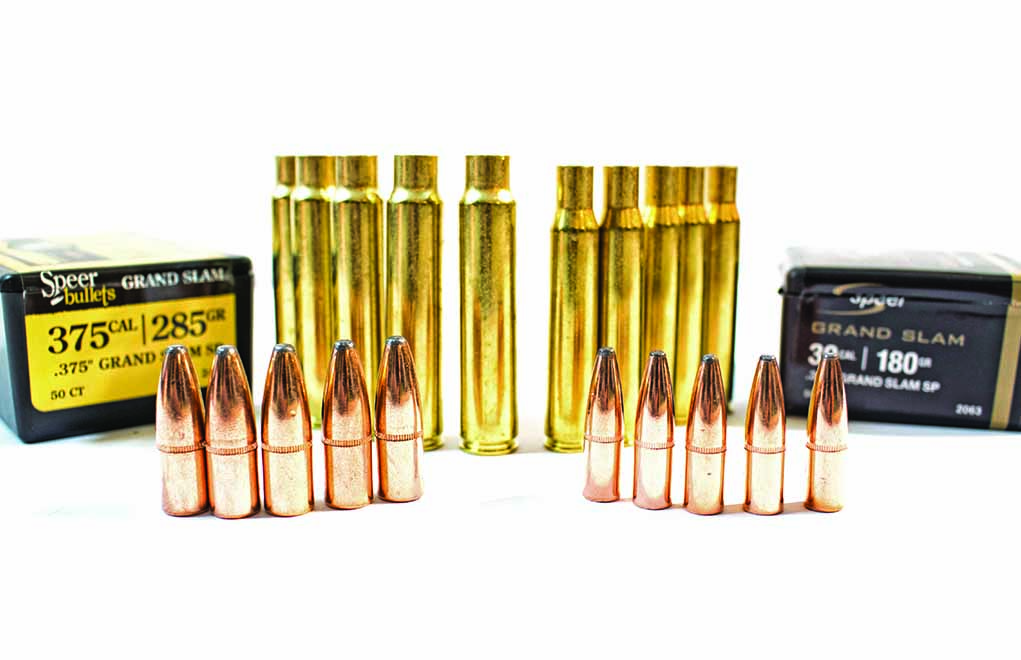
The original design used two lead cores of differing hardness in order to mitigate overly rapid expansion. Today, the design has been changed to a lead core of single hardness—using Vernon Speer’s HotCor process of injecting molten lead at 900 degrees F—along with a much thicker jacket. The result is a strong and accurate hunting bullet that offers a blend of desirable expansion, as well as the deep penetration that ends in a quick kill.
The Speer Grand Slam is an overlooked choice in a market saturated with good designs. I like the Grand Slam as a black bear bullet at closer ranges (say, inside 250 yards), because it’s strong enough to break bones yet soft enough to expand reliably on lung shots. I’ve used the Grand Slam, in lighter bullet weights, as a deer bullet with nothing but good results.
These bullets are wonderfully affordable, with a box of 50 ranging from $15 to $27, and are available in many of the common diameters and weights. Want a great practice/plains game bullet for your .375 H&H or .375 Ruger? Look to the 285-grain Speer Grand Slam.
If you’re hunting bears on a budget with your .308 or .30-06, 165- or 180-grain Grand Slam engenders all sorts of confidence. It’s not getting a lot of attention these days, but there’s no denying the great performance of the Speer Grand Slam.
Bonus: Classic Match Bullet
Sierra MatchKing
In the post-World War II boom, three partners gathered in a Quonset hut and developed a bullet that would set the shooting world on its ear. That bullet—the #1400 .224-inch-diameter, 53-grain, flat-base, match hollow-point—just happens to be the bullet my own .22-250 Remington likes best. Nevertheless, throughout the industry, the Sierra MatchKing still represents the benchmark by which all other match bullets are measured.
Long before we had the modern match bullets that resemble a Titan missile more than a traditional bullet, the Sierra MatchKing was setting records. The 168-grain, .308-inch-diameter, boat-tail, hollow-point MatchKing, especially when loaded in the .308 Winchester, remains a major player.
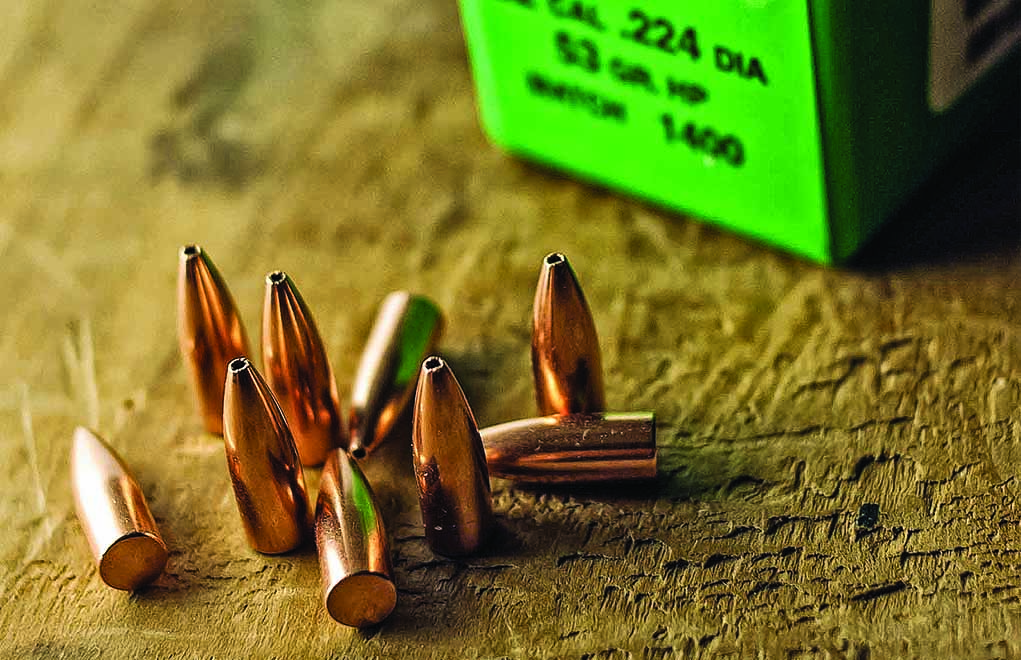
My dad still has a 1970s-vintage box of .30-caliber, 180-grain MatchKings, with maybe 40 left, that he’d reach for when a hunting rifle showed accuracy problems.
“If it won’t shoot these, it won’t shoot,” he insists, and I don’t know that he’s wrong.
Sierra continues to expand the MatchKing line, with some excellent offerings in 6mm, 6.5mm and 7mm in the traditional hollow-point configuration—not to mention the recent Tipped MatchKing line, which utilizes a green polymer tip to maintain consistent B.C. values. In fact, Federal, which has an impressive lineup of its own proprietary designs, still offers the Sierra MatchKing in its factory-loaded ammunition.
Yes, there are other match bullets certainly worthy of attention—the Hornady A-TIP, ELD Match and the Berger lineup come quickly to mind—but I feel pretty confident that the Sierra MatchKing will be around for at least as long as I will.
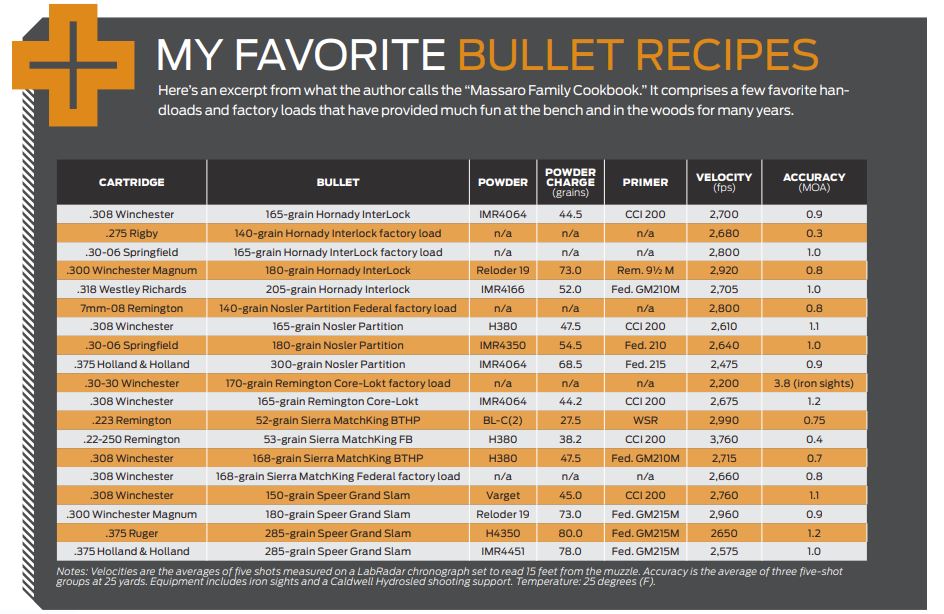
Editor's Note: This article originally appeared in the July 2020 issue of Gun Digest the Magazine.

![Best Concealed Carry Guns In 2025 [Field Tested] Wilson Combat EDC X9S 1](https://gundigest.com/wp-content/uploads/Wilson-Combat-EDC-X9S-1-324x160.jpg)


![Best 9mm Carbine: Affordable PCCs [Tested] Ruger Carbine Shooting](https://gundigest.com/wp-content/uploads/Ruger-Carbine-Shooting-100x70.jpg)
![Best AR-15: Top Options Available Today [Field Tested] Harrington and Richardson PSA XM177E2 feature](https://gundigest.com/wp-content/uploads/Harrington-and-Richardson-PSA-XM177E2-feature-100x70.jpg)
